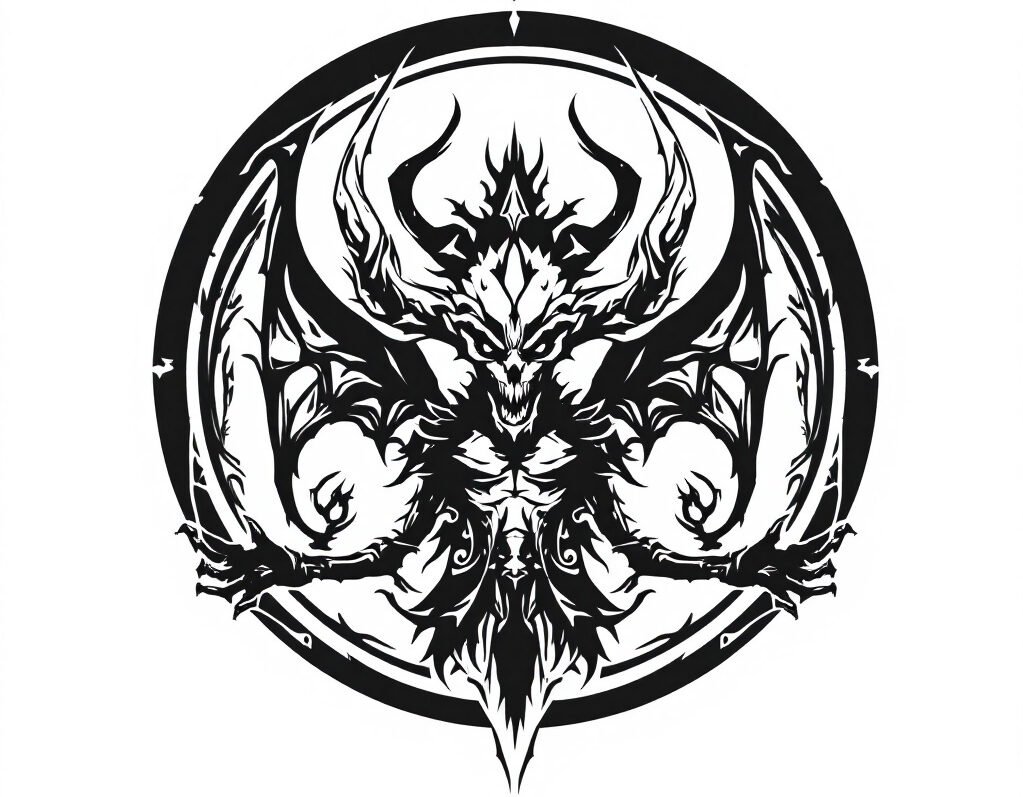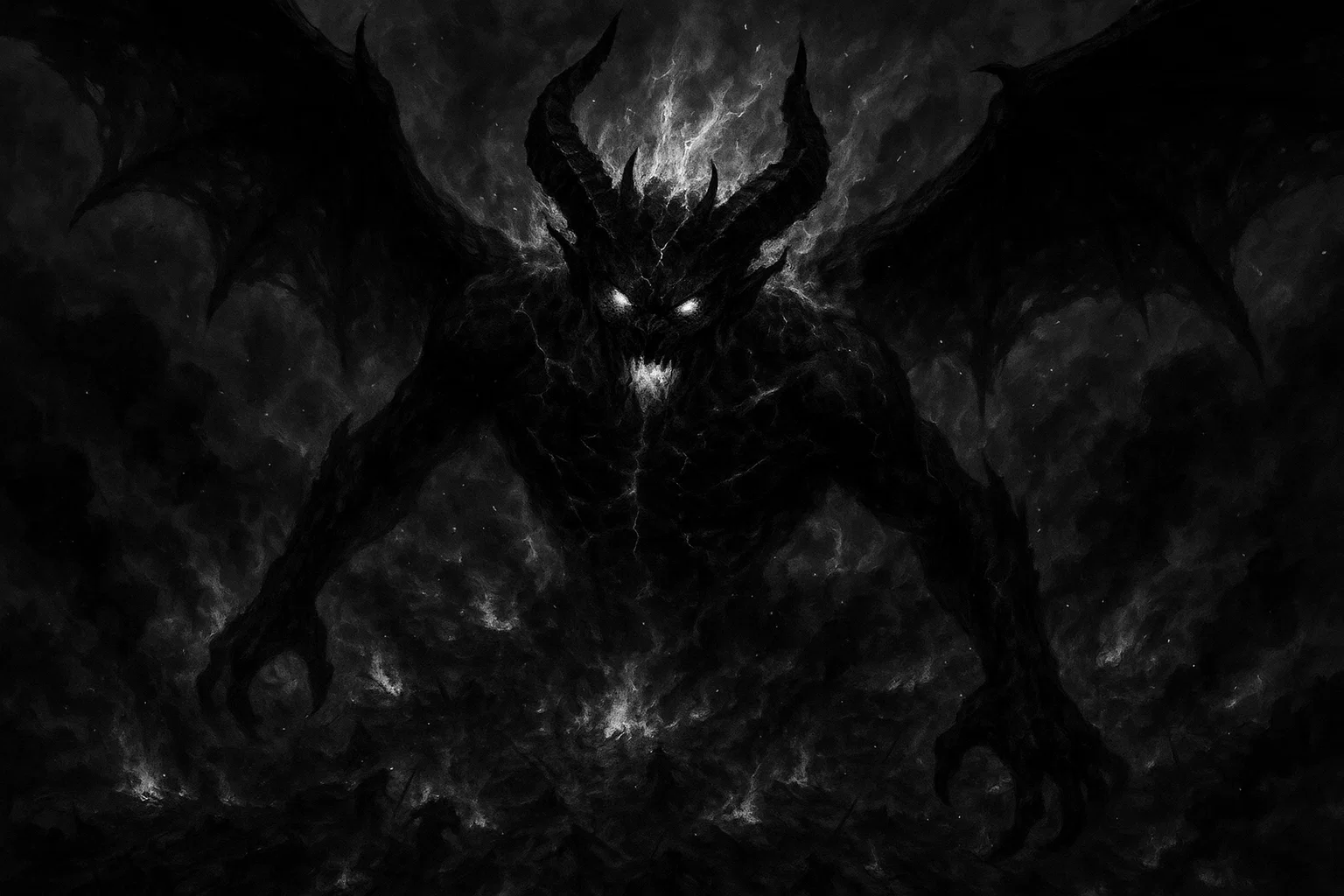The Ifrit is a powerful and malevolent supernatural entity in Islamic tradition, known for its fiery nature and rebellious spirit. Jinn, as a broader category, are invisible beings created by Allah from smokeless fire, distinct from angels and humans, as described in the Quran (55:15). The Ifrit stands out as a particularly cunning and dangerous type, often associated with deception, chaos, and destruction, making it a feared figure in Arabian folklore and Islamic texts.
Originating in pre-Islamic Arabian mythology, Ifrits were later integrated into Islamic theology, where they appear as rebellious jinn opposing divine order. Their fiery essence and shape-shifting abilities make them formidable, often depicted as tempters who lead humans astray.
Summary
Key Takeaways
| Attribute | Details |
|---|---|
| Names | Ifrit, Afarit, Efreet, ‘Ifrīt |
| Type | Fire-based, rebellious jinn |
| Title | King or leader of fire jinn |
| Gender | Ambiguous, often male in depictions |
| Servitors | Lesser fire jinn or unnamed subordinates |
| Superior Jinn | Iblis (Shaytan) |
| Powers | Shape-shifting, fire manipulation, deception, inducing fear, temptation |
| Appearance | Smoky, fiery humanoid or beastly form, often with wings or horns |
| Etymology | From Arabic ‘afara, meaning “to rub with dust” or “to roll in dust” |
| Associated Figures | Iblis, King Sulayman, other rebellious jinn |
| Weaknesses | Repelled by Ayat al-Kursi, Surah Al-Falaq, iron, specific prayers |
| Opposing Holy Figure | Prophet Sulayman, Archangel Jibril |
| Social Structure | Leader of a tribe of fire jinn |
| Followers/Tribe Size | Commands a tribe of fire jinn, size unspecified |
| Element | Fire |
| Planet/Zodiac | Mars, Aries |
| Color(s) | Red, black |
| Number(s) | 7 |
| Crystal(s)/Mineral(s) | Ruby, obsidian |
| Primary Sources | Quran, Hadith, Shams al-Ma’arif, One Thousand and One Nights |
“Ifrit” Meaning
The term “Ifrit” holds significant linguistic and cultural weight, primarily rooted in Arabic origins. Its profound meaning stems from the Arabic word ʿifrīt (derived from the root ʿ-f-r), which conveys ideas of rubbing with dust or rolling in dust.
This root can imply several interesting traits: deception, malice, and cunning. This aligns perfectly with the Jinn’s portrayal as a sly and rebellious entity.
However, the definition has evolved, starting as an epithet in early texts to denote a particularly formidable and wicked spirit. Variants such as ‘ifriya’ and ‘ifr’ appear in pre-Quranic records, indicating early linguistic forms. Some scholars even propose a possible Middle Persian influence, with āfrītan meaning “to create,” though this remains debated.
In Islamic contexts, the name symbolizes power and treachery, reflecting the Ifrit‘s role in tempting and disrupting human affairs. As cultures interacted, Persian and Zoroastrian elements may have shaped the term, adding layers of fiery creation and underworld associations.
Pronunciation
The name “Ifrit” is pronounced in English as “IF-reet,” with the stress on the first syllable. The “I” sounds like the “i” in “bit,” and the “frit” rhymes with “feet.” In Arabic, it is pronounced as “‘Ifrīt” (عفريت), with a guttural ‘ayn sound at the start, which is often softened in English transliterations.
What Does the Ifrit Look Like?
The Ifrit is commonly described as an imposing figure engulfed in fire. Primary sources (such as One Thousand and One Nights) depict this Jinn as a tall, smoky being with glowing eyes, often taking humanoid or beastly forms.
Some texts even mention wings, horns, or cloven hooves, emphasizing their otherworldly nature. Here, the fiery essence of the Jinn—linked to his creation from smokeless fire (Quran 55:15)—manifests as a red or black aura, symbolizing destruction and chaos.
In medieval Arabic manuscripts, the Ifrit can appear as a shadow that emanates fire and smoke. However, his shape-shifting ability allows the demon to transform and appear as animals (such as snakes or scorpions) or as humans to deceive.
In some rarer variations, the Ifrit is invisible, unless summoned.
You may also enjoy:
Who Is Taṇhā, the Seductive Demon of Craving in Buddhist Mythology?
October 15, 2025
What Is the Abumi-guchi Yōkai and Why Does It Wait Forever?
October 22, 2025
Vaisravana: The Golden Guardian King Who Rules the North
October 16, 2025
Banasura: The Thousand-Armed Demon King
October 10, 2025
Who Is Agaliarept, the General of Hell Under Lucifer?
October 8, 2025
Agubanba: The Ash-Born Demon of Japanese Folklore
October 23, 2025
Origins
The Ifrit has deep roots in pre-Islamic Arabian folklore, where it emerged as a powerful, malevolent spirit tied to desolate landscapes and natural forces. Before Islam, Arabian tribes viewed the Ifrit as a supernatural entity hiding in deserts, ruins, and remote areas. Perhaps a symbol of the dangers inherent in such harsh environments?
The Ifrit was regarded as a chthonic being, associated with the underworld and the spirits of the dead. Its name’s variants (like ifriya and ifr) appear in very early records, suggesting an ancient entity.
Old legends tied the Ifrit to murder victims’ blood, where it would form from spilled life force, driven to avenge the dead. This origin explained its vengeful nature, roaming cemeteries or ruins to punish the living. Other tribal stories portrayed Ifrits as guardians of hidden treasures or cursed places, luring or tormenting wanderers.
With the rise of Islam, the Ifrit was reframed within a monotheistic framework. The Quran integrated it as a rebellious jinn, created from smokeless fire, subordinate to Allah’s will.
This shift positioned the Ifrit directly under Iblis, the chief rebel. Furthermore, Islamic theology distinguished Ifrits from angels and humans, placing them in a parallel world where they could choose between belief and disbelief. Over centuries, Hadith and Tafsir expanded their lore, depicting them as tempters or tools in divine narratives, such as interrupting prayers or tormenting prophets.
In Egypt, Ifrits guarded the tombs of pharaohs, blending with local myths. Moroccan folklore often emphasized deformities and the power of supernatural forces over humans.
Was Ifrit Ever Mentioned in the Quran or Hadith?
The Ifrit is explicitly mentioned in the Quran, specifically in Surah An-Naml (27:39-40), where it appears in the story of Prophet Sulayman. The Ifrit offers to bring the throne of the Queen of Sheba (Bilqis) to Sulayman’s court, showcasing its strength and speed, though a human with divine knowledge outdoes it. This reference frames the Ifrit as powerful but subordinate to divine authority.
Hadith collections, such as Sahih Bukhari, mention an Ifrit attempting to disrupt the Prophet Muhammad’s prayer.
Tafsir, like that of Surah al-Anbiya, describes Ifrits tormenting Prophet Job with storms and fire.
| Source | Quote |
|---|---|
| Quran 27:39 | “An Ifrit from among the jinn said, ‘I will bring it to you before you rise from your place, and indeed, I am for this [task] strong and trustworthy.’” |
| Quran 27:40 | “Said one who had knowledge from the Scripture, ‘I will bring it to you before your glance returns to you.’ And when Solomon saw it placed before him, he said, ‘This is from the favor of my Lord.’” |
| Sahih Bukhari 3275 | “An ‘ifrit from among the jinn jumped on me yesternight suddenly, so as to spoil my prayer, but Allah enabled me to overpower him, and so I caught him and intended to tie him to one of the pillars of the mosque so that all of you might see him, but I remembered the invocation of my brother Sulayman: ‘O my Lord, grant me forgiveness and bestow on me a kingdom that will not suit anyone after me.’ So, I scolded him and drove him away.” |
| Tafsir al-Anbiya (on Job) | “After Iblis gains permission to test Job, he descends to earth and summons his most powerful devils (shaytan) and ifrits. In order to torment the prophet, they turn into storms and whirlwinds of fire to destroy Job’s properties.” |
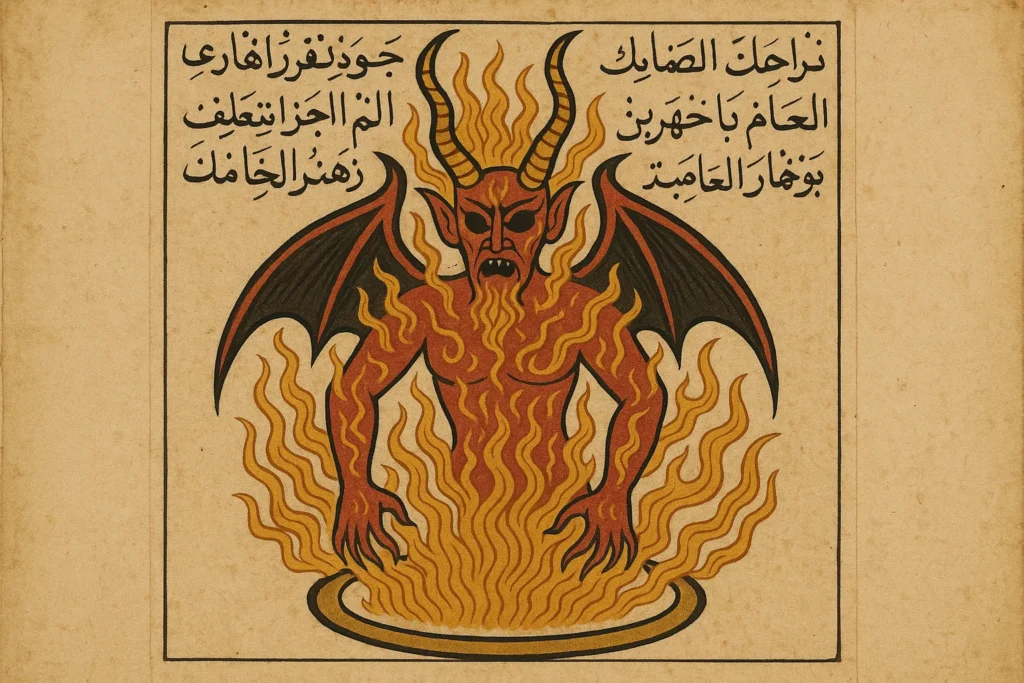
Ifrit in Grimoires and Other Texts
Beyond the Quran and Hadith, the Ifrit features prominently in occult and folklore works, often as a fire spirit with immense power.
In Shams al-Ma’arif (attributed to Ahmad al-Buni), the Jinn is mentioned as a leader among other fire Jinn, capable of shape-shifting and commanding flames.
One Thousand and One Nights depicts Ifrits as treacherous servants, bound by seals like Sulayman’s ring, in tales of fishermen and princes.
Persian texts (like Nizami Ganjavi’s Haft Peykar) depict the Jinn as tormentors in moral journeys, formed from divine wrath.
Syncretic elements appear in Moroccan and Egyptian grimoires, where Ifrits are summoned for strength but risk insanity.
| Source | Quote |
|---|---|
| Shams al-Ma’arif | “The Ifrit, born of smokeless flame, commands the fires of deception and leads astray those who seek its power.” |
| One Thousand and One Nights | “The fisherman opened the bottle, and from it emerged an Ifrit, vast and terrible, whose eyes burned like coals.” |
| Haft Peykar | “An ifrit, formed from God’s wrath, torments Māhān due to his moral transgression, turning from a fairy into a demon.” |
| Kitab al-Bulhan | “Ifrits dwell in desolate ruins, guardians of hidden knowledge, fiery spirits that punish the unworthy.” |
Powers and Abilities
The Ifrit possesses a range of malevolent powers, making it a formidable entity. Its abilities focus on manipulation, destruction, and chaos:
- Shape-Shifting: Ifrits can transform into humans, animals (such as snakes or scorpions), or smoke, allowing for deception.
- Fire Manipulation: They control fire, creating flames or fiery illusions to intimidate or harm.
- Temptation and Deception: Ifrits whisper doubts or false promises, leading humans to sin or disbelief.
- Superhuman Strength: As seen in Quran 27:39, Ifrits possess immense physical power, capable of moving massive objects.
- Inducing Fear: They instill terror through terrifying forms or supernatural phenomena.
You may also enjoy:
Iblis, the Jinn King of Darkness and Deception
September 29, 2025
Who Was Abezethibou, the Fallen Angel Who Opposed Moses?
October 1, 2025
Bali: The Benevolent Asura King of Hindu Mythology
October 10, 2025
Aamon: The Infernal Marquis of Lust, Feuds, and False Prophecies
September 29, 2025
What Is Qarin and Why Does It Follow Every Human Being?
October 8, 2025
Vritra: The Dragon Who Swallowed the Sky in Hindu Mythology
October 7, 2025
Influence on Humans and Possession
Ifrit can exert a profound influence on humans (often through a Qarin, a personal Jinn companion assigned to each individual). The Qarin is particularly evil. It can whisper doubts, fears, or temptations to lead humans astray from faith and morality. This influence manifests as Sihr (sorcery), a concept unique to Islamic theology, where Jinn, such as the Ifrit, cause mental or physical afflictions.
Signs of Ifrit influence include persistent nightmares filled with fiery or shadowy figures, irrational bursts of anger, or overwhelming despair that defies explanation. Physical symptoms (unexplained pain, chronic fatigue, or sudden seizures) are also attributed to Ifrit possession in folklore, particularly in regions like North Africa and the Levant. These afflictions are often interpreted as the Ifrit’s attempt to dominate a person’s will, exploiting weaknesses like greed or pride.
In some narratives, the Ifrit’s possession is more overt, causing victims to speak in unfamiliar voices or exhibit unnatural strength, as noted in Moroccan and Egyptian tales. For instance, a possessed individual might display an aversion to sacred spaces or react violently to Quranic recitations, signaling the Ifrit‘s presence.
Folklore describes cases where the Ifrit targets those who violate taboos—such as entering cursed ruins or dabbling in forbidden rituals—using these breaches to infiltrate their psyche. The Ifrit may also manipulate emotions, fostering envy or wrath, aligning with its association with the sin of anger.
Protection and Exorcism Methods
Islamic texts and folklore provide a range of historical methods for protecting against or expelling an Ifrit.
The most well-known remedy is reciting Ayat al-Kursi (Quran 2:255), which is revered as a powerful shield against the Jinn. This verse, which affirms Allah’s sovereignty, is believed to create a spiritual barrier that repels the Ifrit’s influence.
Hadith narrations, such as those in Sahih Muslim, also recommend reciting Surah Al-Falaq and Surah An-Nas, known as Al-Mu’awwidhatayn (the two protectors), to ward off Sihr and possession. These surahs are recited three times, often at dawn or dusk, to counter the Ifrit’s nocturnal activity.
Ruqyah (an Islamic exorcism practice) involves reciting specific Quranic verses and supplications to expel the Ifrit. Practitioners typically use verses to weaken the Jinn’s hold.
In folklore, iron (believed to cause pain to Jinn) is commonly used—swords, nails, or rods placed near the afflicted. Salt, associated with purity, is sprinkled around homes or beds to ward off the evil spirit.
In North African traditions, burning specific incenses (particularly frankincense or myrrh) is thought to disrupt the Ifrit’s essence.
Amulets with Sulayman’s seal or verses written in saffron ink are worn or hung in homes, drawing on Prophet Sulayman’s authority over Jinn.
Myths, Legends, and Stories
The Ifrit appears in numerous narratives across Islamic texts, grimoires, and folklore, showcasing its cunning, power, and complex relationship with divine authority.
The Ifrit and Prophet Sulayman (Quran)
In the Quran (Surah An-Naml 27:39-40), Prophet Sulayman seeks to bring the throne of the Queen of Sheba, Bilqis, to his court to demonstrate divine power. An Ifrit among the jinn steps forward, its voice resonant with confidence, declaring, “I will fetch it for you before you rise from your seat, for I am strong and trustworthy in this task.”
Immediately, its malevolent presence fills the court, exuding strength as it promises swift delivery of the massive throne across vast distances. Yet, before the Ifrit can act, a human scholar, gifted with knowledge of the Scripture, speaks up, claiming he can bring the throne before Sulayman’s glance returns.
Instantly, the throne appears before the Prophet, who gazes upon it in awe, proclaiming, “This is by the grace of my Lord, to test whether I am grateful or ungrateful.” The Ifrit, though powerful, is outdone by divine wisdom, highlighting its subordination to Allah’s will.
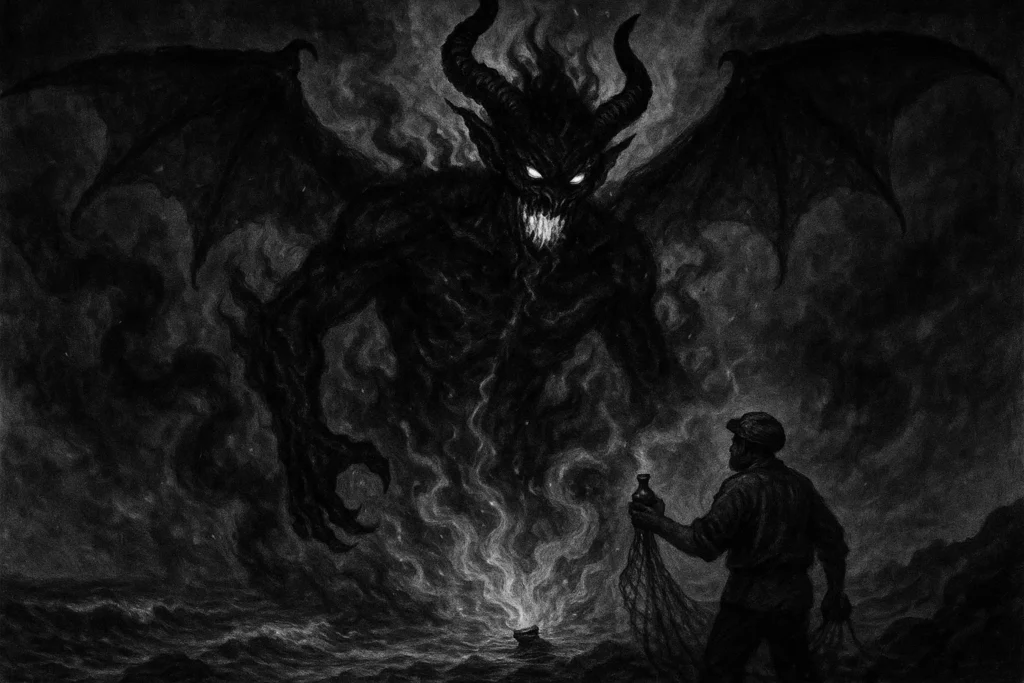
The Fisherman and the Evil Ifrit (One Thousand and One Nights)
In a renowned tale from One Thousand and One Nights, a humble fisherman, struggling to provide for his family, casts his net into the sea four times with no success. On his final attempt, he hauls up a heavy copper jar, sealed with a lead stopper bearing the seal of Prophet Sulayman.
Curious, he breaks the seal, and a thick, swirling smoke erupts, coalescing into a towering Ifrit with eyes like burning coals, a voice like rolling thunder, and a form that darkens the sky. The Ifrit, furious after centuries of confinement, declares, “Prepare to die, for I swore to kill whoever frees me!” It recounts its imprisonment: initially grateful, it vowed riches to its liberator, but as centuries passed in solitude, its gratitude turned to bitter rage.
The fisherman, trembling but clever, questions how so vast a being could fit in such a small jar. The Ifrit, eager to prove its power, transforms into smoke and re-enters the jar. Swiftly, the fisherman reseals it, threatening to cast it back into the sea.
Terrified by the possibility of being trapped again, the Ifrit pleads, offering wealth and sharing its tale of rebellion against Sulayman, who bound it with divine authority.
Moved by its story but wary, the fisherman negotiates, demanding a pledge of safety. The Ifrit agrees, guiding him to a lake teeming with colorful fish—red, white, blue, and yellow—which the fisherman presents to the sultan, earning great riches.
The Ifrit vanishes, leaving the fisherman prosperous but cautious of supernatural encounters.
The Ruins (Arabian Folklore)
In ancient Arabian folklore, a malevolent Ifrit haunts a crumbling desert ruin, its presence marked by flickering flames in the night. A weary merchant, traveling through desolate sands, hears seductive whispers promising untold treasures hidden within the ruin’s depths. Drawn by visions of gold and jewels, he ventures inside, where the air grows hot and heavy.
The Ifrit reveals itself in a burst of fire, its massive form wreathed in smoke, with glowing eyes and clawed hands. It traps the merchant in a maze of fiery illusions, where walls of flame shift and taunt, filling his mind with fear and despair. The poor merchant, lost and desperate, believes he will perish.
Meanwhile, a wise scholar, traveling nearby, senses the Ifrit’s malevolence. Armed with sacred knowledge, he enters the ruin, reciting powerful verses from the Quran, including Ayat al-Kursi. The Ifrit writhes, its flames dimming under the weight of divine words, and attempts to flee but is bound by the scholar’s invocations.
With a final recitation, the Ifrit dissolves into a wisp of smoke, freeing the merchant, who collapses in gratitude. The scholar warns him to shun deceptive promises, and the merchant vows never to heed such whispers again.
Māhān’s Torment (Haft Peykar)
In Nizami Ganjavi’s Persian epic Haft Peykar, the Egyptian traveler Māhān strays from the path of virtue, wandering into a demon-haunted desert. An Ifrit, born of divine wrath, appears initially as a radiant fairy, its form alluring with promises of guidance.
Māhān, captivated, follows, only for the Ifrit to transform into a terrifying demon, its body wreathed in flames, eyes blazing with malice, and voice a guttural roar. It drags him through desolate valleys and treacherous ravines, subjecting him to visions of hellish torments—burning sands, shadowy beasts, and whispers of eternal despair.
The Ifrit accuses Māhān of moral failings, its fiery form shifting to mirror his fears: a snarling dog, a venomous scorpion, a towering inferno. Māhān, overwhelmed, pleads for mercy, confronting his sins in the Ifrit’s illusions.
Through repentance and fervent prayer, he weakens the Ifrit’s hold, its flames fading as his resolve strengthens. Finally, the Ifrit retreats, its purpose as a moral enforcer fulfilled, leaving Māhān to emerge wiser, vowing to uphold righteousness.
Hamou Ukaiou the Evil Ifrit (North African Folklore)
In North African folklore, particularly among Moroccan Berber tales, the Ifrit named Hamou Ukaiou is a dreaded nocturnal predator that stalks lonely roads under the cover of darkness. Known for targeting solo women travelers, he first appears as a charming man, with a handsome face, a soothing voice, and enticing promises of a safe escort.
A young woman, traveling to her village, encounters Hamou Ukaiou, who offers to guide her through a perilous pass. As she follows, the air grows hot, and he reveals his true form: a massive demon with burning eyes, claw-like hands, and a body wreathed in flames. He intends to harm or possess her soul, feeding on her fear.
Hamou Ukaiou is married to Aicha Kandida, a female Jinn who similarly preys on men, their union symbolizing treachery among spirits. The woman, recalling her grandmother’s teachings, begins reciting Surah Al-Falaq and Surah An-Nas. The Ifrit howls in agony, its flames flickering as the sacred words bind its power.
Unable to withstand the recitations, Hamou Ukaiou flees into the night, leaving the woman shaken but safe. She spreads the tale, reinforcing the community’s reliance on protective prayers against such Ifrits.
You may also enjoy:
What Is Qarin and Why Does It Follow Every Human Being?
October 8, 2025
Agubanba: The Ash-Born Demon of Japanese Folklore
October 23, 2025
Ifrit: Demon of Fire Who Serves Iblis in Islamic Tradition
September 30, 2025
Abura-akago: The Oil-Licking Demon Baby
October 22, 2025
Who Is Agaliarept, the General of Hell Under Lucifer?
October 8, 2025
Abadir: The Demon Servant of Chaos and Dispersion
September 30, 2025
The Ifrit and the Porter (One Thousand and One Nights)
In another tale from One Thousand and One Nights, a porter in Baghdad is hired by a group of young women to carry goods to a luxurious house filled with feasts, music, and laughter.
Among them is a prince, cursed by an Ifrit into the form of an ape, his eyes filled with sorrow. The women explain that the Ifrit, consumed by jealousy, transformed the prince for falling in love with its daughter, a radiant jinn. The Ifrit had declared, “No mortal shall touch my kin!” and used its fiery power to bind the prince in this humiliating form, separating the lovers.
The women, pitying the prince, seek to break the curse. They prepare a ritual with sacred oils and chants, confronting the Ifrit when it appears in a storm of flames and smoke, its form monstrous with horns and a lashing tail.
The battle is fierce; the spirit unleashes fiery illusions, conjuring visions of burning cities and snarling beasts. One woman, skilled in exorcism, sacrifices herself, chanting divine words that turn the Ifrit to ash.
In the end, the prince is restored but loses an eye in the ordeal, a mark of the Ifrit’s wrath. He marries one of the women, who becomes his queen, and they honor the fallen heroine.
The Sorcerer’s Apprentice (Moroccan Folklore)
In a Moroccan folktale, a young apprentice to a sorcerer seeks forbidden knowledge, ignoring his master’s warnings. Drawn to a hidden grimoire, he recites an incantation to summon an Ifrit for power and wealth.
The air fills with sulfur, and the demon appears. A swirling mass of fire and smoke, with jagged teeth and eyes like molten lava. It promises the apprentice dominion over men but demands his soul in return.
The apprentice, greedy and naive, agrees, unaware of the Jinn’s deceit. The Ifrit begins to possess him, filling his dreams with visions of fire and ruin, causing him to lash out in rage.
His master, sensing the disturbance, confronts the Ifrit, wielding a talisman inscribed with Sulayman’s seal. The Ifrit roars, attempting to burn the sorcerer with flames, but the master recites Ayat al-Kursi, binding the Ifrit in chains of divine light. The Ifrit is banished to a desolate realm, and the apprentice, freed but humbled, vows to respect sacred boundaries.
Ifrit vs Other Jinn
The Ifrit shares some traits with other Jinn. However, he also stands out for its malevolent, deceiving, and rebellious nature:
| Jinn Name | Associated Traits/Influence | Rank/Origin | Key Traits/Powers |
|---|---|---|---|
| Marid | Pride, rebellion | King of sea jinn, Quran | Grants wishes, immense strength |
| Ghul | Deception, grave-haunting | Follower, Arabian folklore | Shape-shifting, lures victims |
| Shaitan | Temptation, evil | Leader under Iblis, Quran | Incites sin, whispers doubts |
| Qarin | Personal influence | Companion jinn, Hadith | Influences thoughts, subtle |
| Jann | Neutral, desert-dwelling | Lower rank, folklore | Hides in oases, minor tricks |
| Nasnas | Mischief, chaos | Lesser jinn, folklore | Half-human form, causes confusion |
| Hinn | Servitude, animal-like | Lower rank, pre-Islamic | Serves higher jinn, weak powers |
| Si’lat | Seduction, trickery | Female jinn, folklore | Lures men, shape-shifts |
| Palis | Vampiric, foot-licking | Lesser jinn, folklore | Drains energy, nocturnal |
| Shiqq | Deformity, chaos | Lesser jinn, folklore | Half-bodied, causes fear |
| Jinnati | Neutral, community-based | Tribal jinn, folklore | Protects or harms tribes |
| Buraq | Evil, desert-bound | Lesser jinn, folklore | Haunts travelers, illusions |
| Hatif | Invisible voice, deception | Lower rank, folklore | Mimics voices, misleads |
| Mal’ak | Ambiguous, messenger-like | Neutral jinn, folklore | Delivers omens, neutral |
| Ruqyah Jinn | Healing or harm | Ambiguous, Hadith | Affects exorcisms, variable |
Position Among Jinn
The Jinn’s society mirrors that of ancient Arab tribes, with kings, clans, and marital alliances, sometimes involving intermarriage with humans to produce hybrid offspring. Within this complex society, the Ifrit occupies a prominent position in jinn hierarchies, often regarded as one of the most powerful and rebellious types of Jinn.
In Islamic texts (such as Shams al-Ma’arif), he leads the tribes of fire Jinn, commanding lesser spirits in acts of deception and destruction. It falls under Iblis, aligning with the Shayatin as a high-ranking devil, more formidable than ordinary Shaytan but comparable to marids in strength.
Power levels vary. Ifrits surpass lower Jinn like hinn or ghuls but can be bound by superior forces, as in Sulayman’s control.
Follower counts remain vague in sources, but Ifrits oversee groups of fire-based subordinates, enforcing moral or vengeful duties.
Alliances form with other rebellious Jinn for chaos, while rivalries exist with obedient ones or marids over dominance.
Classifications by al-Buni place Ifrits among chthonic spirits, tied to the seven layers of the earth.
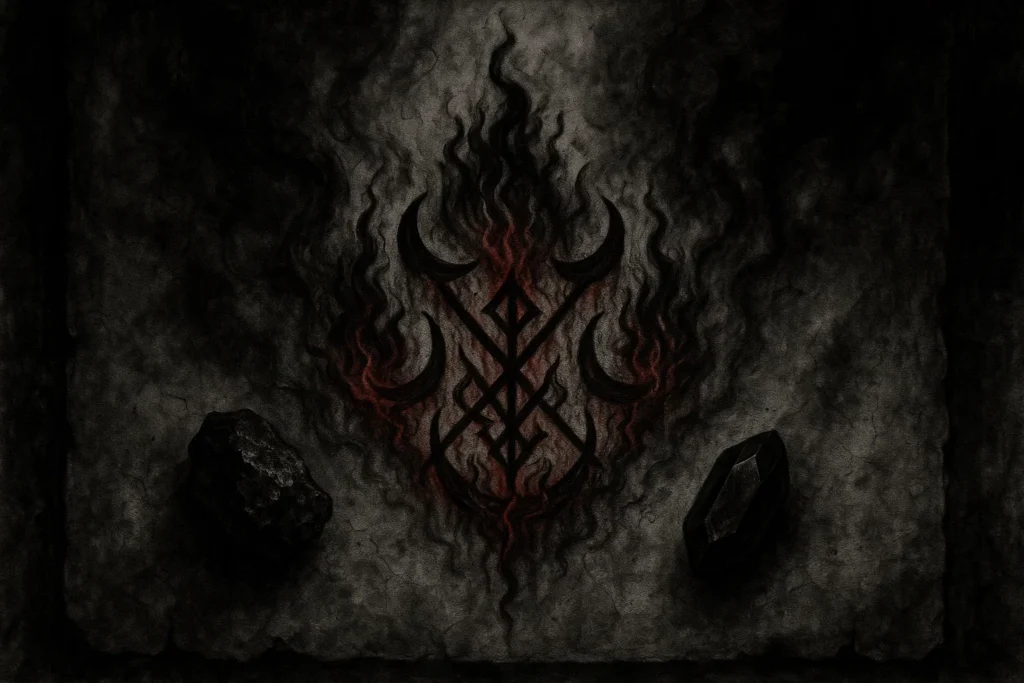
Associations
The Ifrit is typically associated with the primordial element of fire, as well as the planet Mars, the gem ruby, the number 7, and the color red.
Zodiac and Astrological Links
The Ifrit is strongly tied to Mars, the planet of war, aggression, and raw energy, which enhances its destructive capabilities, such as conjuring flames or inciting conflict.
In occult texts like Shams al-Ma’arif, Mars governs the Jinn’s ability to dominate or intimidate, making Martian hours—particularly Tuesday nights—ideal for rituals involving its power.
The zodiac sign Aries, ruled by Mars, aligns with the Ifrit’s impulsive, leadership-driven nature, as it commands fire jinn tribes. Some grimoires suggest a secondary link to Scorpio, another Mars-ruled sign, emphasizing the Ifrit’s vengeful and secretive traits.
Elemental Associations
The Ifrit is intrinsically linked to fire, its defining element, as stated in Quran 55:15, which describes Jinn as created from smokeless fire. This primordial element symbolizes destruction, passion, and rebellion. It manifests in the demon’s appearance as a smoky, flame-wreathed figure, and it is also capable of manipulating flames or creating fiery illusions.
In folklore, Ifrits inhabit hot, arid environments, such as deserts or volcanic regions.
The South, associated with heat and intensity in Islamic cosmology, is often linked to Ifrits, particularly in Arabian and North African traditions, where they are said to emerge from southern deserts.
Some texts suggest a minor connection to the earth, tying back to the etymology of “rubbing with dust,” which indicates their ability to manipulate ash or scorched ground.
Colors, Numbers, and Crystals
The Ifrit is associated with red, symbolizing anger, blood, and fire, and is often used in talismans or candles to invoke its presence. The demon is also linked with the color black (chaos, the underworld, and hidden malice).
The number 7 holds mystical significance, tied to the seven layers of the Earth where demons are said to dwell, or the seven sins they are said to embody, particularly wrath.
In Shams al-Ma’arif, ruby is tied to the Ifrit for its fiery shade and association with power, used in rituals to amplify its influence. Obsidian, a volcanic glass, symbolizes protection and darkness, often employed to bind or repel the Ifrit. Garnet, another red stone, is sometimes mentioned in Persian texts for its connection to passion and strength, enhancing the Ifrit’s fiery aura in occult practices.
Other Correspondences
The Ifrit is linked to iron, symbolizing unyielding strength. However, paradoxically, it is a weakness when used against it, as folklore suggests that iron repels Jinn.
Animals associated with these legends include scorpions (for their venomous treachery), snakes (for their deceptive and stealthy nature), and dogs (for their role as guardians of cursed ruins).
Sulfur evokes the Ifrit’s foul, hellish odor, tied to its fiery essence and underworld connections.
Henbane (or nightshade), associated with poison and sorcery, is linked in grimoires to Ifrit rituals.
The sin of wrath defines its influence, inciting anger and violence in humans.
Sensory associations include acrid, burning smells and intense heat, often reported during Ifrit manifestations. Modern occult extensions may also include cinnamon for its potent scent or coal for its link to charred destruction.
Ifrit’s Sigil and Symbols
The Ifrit’s sigil, as detailed in Shams al-Ma’arif and other grimoires, is a complex geometric design featuring interwoven flames, crescents, and jagged lines, symbolizing its fiery essence and chaotic nature.
Typically drawn with red ink on parchment or etched into iron, the sigil is used in talismans to summon, bind, or repel the evil spirit. The flame motifs represent its destructive power, while crescents signify its hidden, mysterious influence, often tied to lunar phases in rituals.
Persian grimoires (like those in the Kitab al-Bulhan) add star patterns to the sigil, reflecting the Ifrit’s celestial ties to Mars.
Beyond the sigil, other symbols include the flame, often depicted in medieval Arabic art as surrounding the demon. The crescent moon represents secrecy and nocturnal activity, aligning with its ability to deceive under the cover of darkness.
Summoning and Rituals
Grimoires describe summoning an Ifrit through elaborate rituals requiring precise conditions and tools. A circle of fire, lit with red candles or burning sulfur, must be drawn to align with the Ifrit’s fiery nature. The summoner inscribes the Ifrit’s sigil on parchment or iron, using red ink or blood to invoke its presence.
Incantations, often invoking Iblis or referencing Prophet Sulayman’s authority, are chanted to call the Ifrit forth, with phrases drawn from Quranic verses or occult texts. Offerings, such as sulfur, myrrh, or animal blood, are placed within the circle to appease the Ifrit’s volatile temperament.
Binding the Ifrit requires invoking Sulayman’s seal, a divine artifact said to control Jinn, as described in Quranic narratives. Some rituals involve iron tools, like daggers or chains, to weaken the Ifrit if it turns hostile.
In Persian traditions, mirrors are sometimes used to trap the Jinn’s reflection, thereby limiting its shape-shifting abilities.
You may also enjoy:
Who Is Adrammelech in Demonology and the Bible?
October 1, 2025
Who Is Aka Manto, Japan’s Terrifying Red-Cloaked Yōkai?
October 24, 2025
Abura-akago: The Oil-Licking Demon Baby
October 22, 2025
Who Was Abezethibou, the Fallen Angel Who Opposed Moses?
October 1, 2025
Palden Lhamo: The Black Goddess of Blood and Protection
October 20, 2025
What Is Qarin and Why Does It Follow Every Human Being?
October 8, 2025
